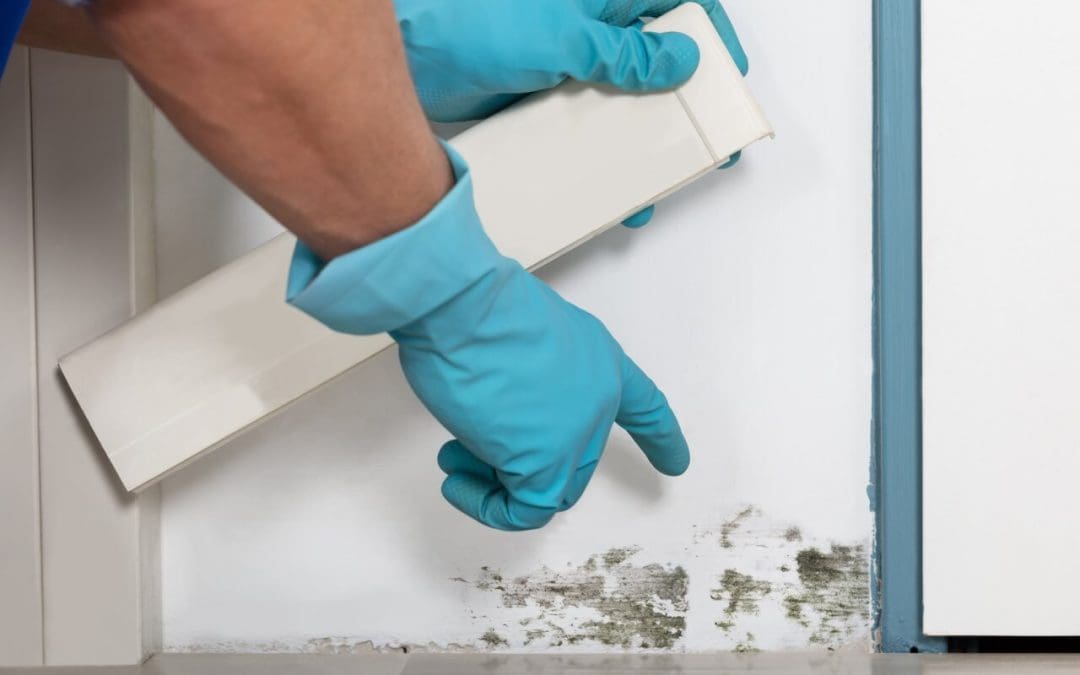Mold is unsightly, unhealthy, and expensive to remediate. Early detection is homeowners’ best shot at preventing the spread of mold and the associated health risks it brings. If you’ve been wondering whether that patch of discoloration is just a stain or an indication of something worse, learn about these common signs of mold growth in your home.
Mold Growth Signs and Symptoms
1. Musty Odors
One of the first signs of mold growth isn’t a visual cue; it’s the smell. Mold can produce a distinct and unpleasant odor, commonly described as musty or earthy. This odor is often stronger when the area has been damp or humid for a long time. If you notice a smell but can’t pinpoint its exact location, call a mold professional for an inspection.
2. Visible Signs of Mold Growth
Mold thrives in damp, dark environments and often appears in areas not easily visible, such as under sinks, behind furniture, and in attics. These ‘hidden’ patches may be discovered when symptoms become severe, but visible growth on walls, floors, or ceilings is a sure sign you have a mold issue. Look for areas that seem stained or discolored and spots that appear fuzzy or slimy.
3. Water Damage
If any part of your home has suffered water damage recently, whether from flooding, leaking pipes, or a malfunctioning appliance, mold is likely to come with it. Mold can start to grow within 24-48 hours of water exposure, so dry the area promptly and thoroughly. Even if you think you’ve dried the area completely, hidden moisture could still foster mold growth. Use a dehumidifier in the area and order a test for mold.
4. Signs of Mold Growth: Health Symptoms
Mold exposure can have a variety of health effects, especially for those with preexisting respiratory conditions. Common symptoms include coughing, sneezing, itchy eyes, skin irritation, and asthma attacks. If people in the household are experiencing recurring or worsening symptoms in a specific area of the house, it could indicate mold affecting the indoor air quality.
5. Be Vigilant in Humid Areas
The battle against mold is more challenging where the humidity is high or where condensation forms, as moisture is a primary ingredient for mold growth. Areas with humidity of over 60% are at a higher risk. If you have high moisture levels in the air, use a dehumidifier and watch for other signs of mold in the home.
6. Professional Confirmation
When in doubt, consult a professional. Mold removal specialists will inspect your home for signs of mold behind walls, under flooring, and in other less obvious locations. They can also test the mold to determine the type and if it poses health risks. Experts have the knowledge to handle mold safely and completely.
The earlier you detect mold growth in your home, the easier and less costly it is to eliminate. Regularly inspecting areas prone to moisture and promptly dealing with water damage are essential steps in preventing mold in your home. Mold spores pose health risks, so address issues promptly to ensure a safe, healthy living environment for you and your family.
FAQs
What are effective ways to prevent mold growth in a home?
To prevent mold, control moisture levels. Maintain good ventilation in moisture-prone areas, such as bathrooms, kitchens, and basements. Use exhaust fans, dehumidifiers, and air conditioners to reduce humidity. Fix leaks promptly, insulate cold surfaces to reduce condensation, and dry water-damaged areas within 48 hours to prevent mold growth.
Are some molds more dangerous than others?
Yes, some molds produce mycotoxins, which pose health risks, while others are less harmful. Stachybotrys chartarum, commonly known as black mold, is one example of a mold that can produce mycotoxins and may cause severe health issues. However, it’s important to note that individual sensitivities vary, and other molds can cause allergic reactions or respiratory problems in susceptible individuals.
What are the health risks associated with mold in a home?
Mold exposure indoors can cause various health problems, including allergic reactions and respiratory issues. Family members might experience worsened asthma, coughing, wheezing, throat irritation, headaches, and skin and eye irritation. Prolonged exposure to mold and mycotoxins may lead to more severe health issues in some individuals, especially those with compromised immune systems or pre-existing respiratory conditions.
What steps should I take if I suspect mold growth in my home?
Inspect areas prone to mold. If you find mold growth, clean the affected area with a solution of water and detergent and dry it thoroughly. Consult a professional mold remediation specialist for extensive mold growth or persistent moisture issues.
Can mold growth cause health issues even if I can’t see or smell it?
Yes, mold can still pose health risks even if you can’t see or smell it. Mold spores are microscopic and can be present in indoor air even when mold growth is not visible. Some molds may not produce strong odors, especially in the early stages of development. If you experience unexplained respiratory symptoms or allergic reactions, test for mold and improve ventilation and moisture control in your home.
Lakeland Home Inspection Service offers professional home inspections to customers in Polk County, West Hillsborough County, and surrounding areas. Contact us to schedule an appointment for our services.

